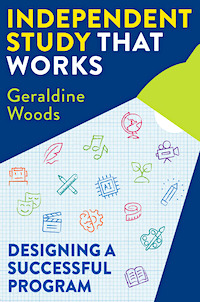Independent Study for Middle Schoolers
Teacher Geraldine Woods is the author of more than 50 books for educators and the general public, including numerous entries in the popular Dummies series. English Grammar For Dummies is one impressive example.
By Geraldine Woods

I was prepared for those reactions, given that kids tend to like some subjects (and teachers) more than they like others. However, I wasn’t prepared for the fog that settled over her features when she explained that her school reserved one period of the day for independent study.
“It’s when a teacher tells you what work you have to do. But no one checks anything, so a lot of kids just sit there.” She applied what is arguably the worst label a tween can muster: “Independent study is boring!”
“How about flipping the model?” I countered. “What if you told the teacher what work you’d do and the teacher checked everything?”
The fog lifted and a bright smile emerged. “That would be awesome,” she said.
And it is awesome. I know because I was in charge of independent study at my school for more than a quarter century. During that time, student after student not only met but exceeded my expectations – and not just “good students,” a highly suspect designation at the best of times.
I saw struggling students become stars and disengaged learners take ownership of their education. Although I worked mainly on the high school level, I’ve applied independent study methods to middle school classes and witnessed many other teachers do so as well.
Independent study, whether it’s a full-on program or a small change to an existing assignment, can be successful in a variety of settings: schools both large and small, well-resourced and underfinanced, public and private. It’s adaptable for homeschooling as well.
I’m convinced that some version of independent study will work for most middle school students if three basic principles are present: student choice, adult guidance, and students teaching students.
1. Student Choice
We don’t often ask kids what they want to learn. That’s as it should be. We’re the professionals with the training and experience to see the big picture. We understand which skills and information students need to take the next step in their lives.
Yet surely there’s room in the school year for a class or a unit, even just one assignment, based on a simple question: “What do you want to learn or create?” Ask that question and watch the floodgates open. A few responses will be well defined, the perfect starting point for an independent project. Some will be too broad (“music”) and some too ambitious (“build an energy-efficient house”). A couple may be too limited (“identify the world’s tallest mountain”). No problem! All you have to do is ask more questions:
- Music project – What sort of music? Are you interested in the instruments or the musicians or the business? Would you like to do research, or do you want to compose or perform?
- Energy-efficient-house project – Will you study how energy-efficient devices work? Do you want to draw plans for an energy-efficient house? Construct a model?
- Mountain project – Once you identify which mountain is the world’s tallest, would you like to explore how mountains are measured? Do you want to research the geological forces that shaped the mountain? Which plants and animals live in that environment?
I could go on, but you see how the process works. The student’s idea remains central, but the teacher’s input is key – which brings me to the second essential element of independent study.
2. Adult Guidance
As philosophers and cartoon superheroes often point out, with power comes responsibility. Kids have an innate understanding of power, whether it’s their own or an authority figure’s. But responsibility must be taught or, more accurately, nurtured. To keep students on track, erect sturdy guardrails:
Frequent check-ins – At every stage, from the project definition I described above through to the final product, monitor what each student is doing. This can happen during a short conversation (some teachers schedule five-minute “appointments” on the side of the room while the class works on independent projects) or in a written work log.
- Intermediate goals – Help students identify the steps and interim goals for their work. For a sculpture project, this might be collecting photos of statues, reading a book about materials and techniques, sketching the planned artwork, and sculpting it. For a history research project, the student might identify possible sources (written and human), take notes, organize the material, and create a report.
- Deadlines – Work with students to set deadlines for every step of the project, check the work when it’s due, and define appropriate consequences if anything is late. The deadlines can be individual (the sculptor turns in work on Tuesday, the historian on Friday) or uniform (everyone’s first step completed by the same date).
- Defined product – Projects work best when they culminate in an expression of knowledge. Guide students to consider all the possibilities – a written report, an infographic, a website, a performance, an exhibit, a computer program, or something else.
Another way to create guardrails is to approach independence gradually. You might start with a teacher-defined assignment, as one science teacher did.
First, she distributed materials and asked students to fashion them into axles and wheels for a “go-rig.” Next, students worked during class to improve the speed and maneuverability of their vehicles. Finally, at home they created another go-rig of their own design, using any materials they wished.
Throughout this process, the teacher was available for help. So were other students: whenever someone had a breakthrough, the teacher identified the student as a “local expert” whom others could consult. Students taught their peers – the third principle of effective independent study.
3. Students Teaching Students
We teachers know that we understand a topic on a deeper level when we teach it to someone else. Why not give that opportunity to our students? As in the science project I described above, a student who has mastered a skill can demonstrate it to classmates, freeing the adult teacher for other duties and imparting confidence and satisfaction to the student-teacher. Alternatively, you can designate a “teaching day” for each student.
Here’s an example of the student-as-teacher approach from an English course I taught. In the early years of my career, one of my standard assignments was a poetry report. Students were to select a work from a list I provided, study the poem carefully, and present their findings to the class. I allotted ten minutes for each report.
The class was always outwardly attentive, but I knew many minds were wandering behind the polite faҫade. How could they not? Essentially, I was subjecting them to a lecture – a teaching method I myself would never use at the pre-college level.

This small change made all the difference. What was once a passive listening experience became active engagement with the text. I’d like to attribute this to love of learning, but I suspect students’ eagerness to participate arose partly from self defense, as they knew they’d all eventually take a turn as teacher. “If I make a comment during Cathy’s discussion,” I imagined them thinking, “she’ll probably say something about my poem.”
The student-as-teacher model can be adapted to many time frames. It can be compressed into a short period (say, each student teaches for 15 minutes) or expanded to a thread woven throughout the entire year (one student-led class per week). If time is tight, students team-teach with one or two peers.
The Takeaway
Independent study isn’t an addition to your already over-stuffed curriculum and weekly schedule. Instead, it’s a shift from teacher-required assignments to self-motivated work.
As they pursue their projects, students who were passive recipients of information embark on an intriguing hunt for knowledge, and they expand the number of people they can turn to for information and assistance. Instead of performing for an audience of one (the teacher), students present their work to their peers.
And that, as my middle school friend said, is awesome.

Geraldine is the creator of the Grammarian in the City blog, which explores (often with humor and irony) a variety of topics related to language, grammar, and writing. She lives in New York City.































